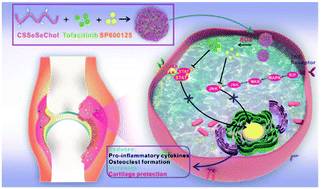A biopolymer-based and inflammation-responsive nanodrug for rheumatoid arthritis treatment via inhibiting JAK-STAT and JNK signalling pathways†
Abstract
Rheumatoid arthritis (RA) is a common chronic autoimmune disease associated with progressive disability, systemic complications, and poor prognosis. The improved understanding of the roles of immune signaling pathway inhibitors has shed light on designing new and more effective approaches for RA treatment. In this work, an inflammation-responsive and molecularly targeted drug system has been developed for RA therapy. The drug carrier was synthesized by covalently grafting hydrophobic cholesterol (Chol) molecules onto a hydrophilic chondroitin sulfate (CS) chain via the inflammation-responsive diselenide bonds (SeSe). The resultant amphiphilic polymer CSSeSeChol readily forms nanoparticles (NPs) and encapsulates two kinase inhibitors tofacitinib and SP600125 in aqueous media. Upon administration into the RA mouse model, the nanodrug accumulates in RA lesions and releases the inhibitors for regulating the JAK-STAT and JNK pathways. As a result, the nanodrug exhibits satisfactory efficacy in RA treatment by suppressing the expression of relevant pro-inflammatory cytokines, blocking the activation of osteoclasts and providing protection for cartilage and joints.

- This article is part of the themed collection: 2020 Nanoscale HOT Article Collection


 Please wait while we load your content...
Please wait while we load your content...